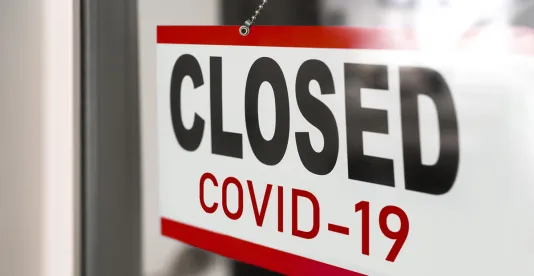On April 30, 2020, Minnesota Governor Tim Walz issued Emergency Executive Order (EO) 20-48, extending Minnesota’s stay-at-home order through May 18, 2020, but providing the opportunity for some Minnesota retailers to begin reopening under certain conditions. Here are three core questions and answers regarding EO 20-48 that employers may want to keep in mind.
Question 1: What does EO 20-48 permit?
Answer 1. Specifically, EO 20-48 permits the reopening of additional Minnesota businesses by allowing Minnesota retailers that sell goods to engage in curbside or outside pickup and delivery provided that they:
-
do not allow customers to enter the business premises;
- create a COVID-19 Preparedness Plan that follows Minnesota Department of Health (MDH) and Centers for Disease Control and Prevention (CDC) guidelines and meets Occupational Safety and Health Administration (OSHA) standards; and
- follow the health and safety protocols, policies, and procedures outlined in EO 20-48, including conducting health screenings of workers.
EO 20-48 mandates, however, that all workers who can work from home must continue to do so.
Q2. Which businesses are allowed to reopen under EO 20-48?
A2. The Minnesota Department of Employment and Economic Development (DEED) has issued guidance on EO 20-48, providing details on which businesses may reopen and under what conditions.
Under DEED’s guidance, “retail stores and businesses that sell, rent, maintain, and repair goods that can be picked up outside, without entering the place of business, and with limited interaction between employees and customers” may provide curbside pickup and delivery services. DEED provides examples of such businesses, including household goods rentals, repair and maintenance services, and pet grooming businesses. DEED also notes that in order to provide delivery, a business must have provided delivery services prior to the pandemic.
In addition, DEED provides examples of what such retail employers may and may not do under EO 20-48. For example, employers may:
- “Allow customers to pick up purchases made in advance online or via telephone,” and pay electronically … whenever possible;
- Have employees maintain social distancing when working inside the store to facilitate outdoor pickup;
- Ensure customers remain in their vehicle[s] while workers deposit items in vehicle trunks, whenever possible; and
- Provide contactless delivery at a customer’s home
DEED’s examples of what employers may not do include:
- allowing customers into retail stores or business premises
- “conduct[ing] customer visits in customer workplaces or homes”; and
- having workers work in close proximity to each other.
Executive Order 20-48 expands upon Executive Order (EO) 20-40 (April 23, 2020), which allowed non-critical sector workers in industrial and office settings to go back to work, with certain conditions. The “Non-Critical Exempt Businesses” covered by EO 20-40 included non-critical sector industrial or manufacturing businesses, including those involved in wholesale trade, warehousing, and places of employment in which goods are being created. It also included non-critical sector office-based businesses where workers do their work within an office space, at their desks, and where their work is primarily not customer facing.
Q3. What must a COVID-19 preparedness plan include?
A3. EO 20-40 and EO 20-48 both require each non-critical business operating in Minnesota during the peacetime emergency to establish a COVID-19 preparedness plan. The Minnesota Department of Labor and Industry (DLI) has accordingly provided a template “COVID-19 Preparedness Plan” for Minnesota employers.
Pursuant to EO 20-48, each preparedness plan must:
- require remote work whenever possible;
- ensure that sick workers do not enter the workplace;
- “establish social distancing policies and procedures”;
- “establish hygiene and source control policies for workers”; and
- “establish cleaning and disinfection protocols for areas within the workplace.”
The completed plan is not required to be submitted to DLI for approval, but needs to be made available upon request by either DLI or other regulatory authorities and public safety officers. EO 2020-48 also requires that be posted in the workplace. If physical posting is not practicable, it can be posted electronically, provided that it “is received by all workers and remains available for their review.”
DLI further noted that an employer’s COVID-19 preparedness plan “shall establish and explain the necessary policies, practices and conditions to meet” the CDC and MDH guidelines for COVID-19, along with OSHA standards “related to worker and customer—if the business has customer-facing operations—exposure to COVID-19.”
DLI further stated that each plan “should have the strong commitment” by the employer’s management team and “be developed and implemented with the participation of workers.” DLI, in consultation with MDH, is authorized to determine whether a plan is adequate.
Further, under EO 20-48, DLI notes that an employer’s COVID-19 preparedness plan must include and describe how its business will implement (at a minimum) the following:
- “infection prevention measures;
- prompt identification and isolation of sick persons;
- engineering and administrative controls for social distancing;
- customer controls and protections for drop-off, pick-up and delivery;
- housekeeping, including cleaning, disinfecting and decontamination;
- communications and training for managers and workers necessary to implement the plan; and
- provision of management and supervision necessary to ensure effective ongoing implementation of the plan.”
DLI’s template COVID-19 preparedness plan meets the criteria listed above, but employers are not required to use it. DLI stated that any employer that chooses to use the template must adapt it to fit the specific needs of the employer’s business.
Finally, DLI provides an appendix of linked resources for use in developing a preparedness plan.
Key Takeaways
EO 20-48 permits the reopening of additional Minnesota businesses as the state continues to combat the COVID-19 pandemic by allowing non-critical retailers to offer curbside pickup or delivery provided certain requirements are met, including developing a COVID-19 preparedness plan. Employers and businesses covered by EO 20-48 may want to ensure they are up-to-date and familiar with its requirements for reopening, and develop their COVID-19 preparedness plans consistent with DLI guidance on the topic.





 />i
/>i

